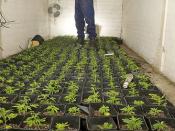The Case for Cannabis
What if there were a plant that could produce more than four times as much paper as a tree with 60-80% less chemicals, make a fabric stronger, lighter, and more resilient than cotton, require little or no pesticides to grow, replace every fossil fuel with a cleaner burning, renewable biomass, and relieve people with serious illnesses of at least some of their maladies? What if you were told that this plant does exist, but had been outlawed for nearly 80 years? What would you think? Well, such a plant does exist, and has been outlawed since 1937.
Cannabis hemp, from the Cannabis Sativa L. plant, is one of the most useful plants in the world. It is an herb with a woody stalk, reaches heights of 12-20 feet, and produces some of the strongest yet softest fibres of any plant on earth. The woody husk can be turned into pulp for paper, the fibres used for cloth or rope, and the flowers and leaves can be used for relaxation and medicines.
The hemp oil acquired from the plant can be refined in much of the same way as petroleum products, and produce almost all of the same substances. The seeds can be eaten, and are have the highest amount of essential fatty acids of any other edible plant (Herer p.5-9, 45-49). Truly, every part of this plant can be used, which is a lot more than can be said for many of the other plants we use in this day and age. Furthermore, it's hardy enough to be grown from the equator all the way up to the Arctic Circle (and down to the Antarctic, as well), and is a natural repellant to pests.
For these reasons, it's not hard to imagine why hemp was the...


